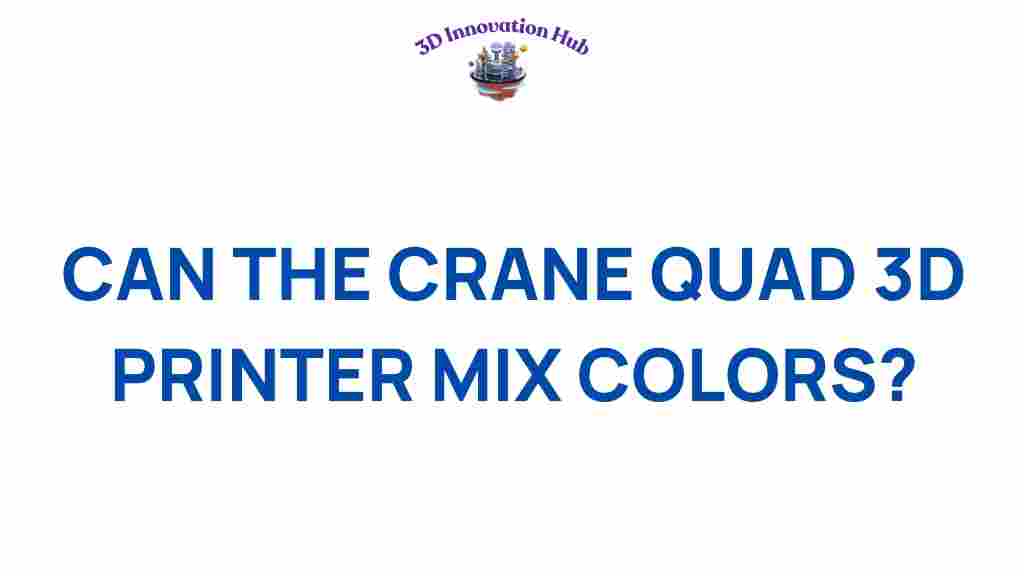Unveiling the Crane Quad: Can This 3D Printer Truly Mix Colors?
The world of 3D printing has seen tremendous advancements over the years, with innovations that push the boundaries of what’s possible in design and manufacturing. Among the latest breakthroughs is the Crane Quad, a revolutionary 3D printer that claims to mix colors in a way that sets it apart from traditional models. In this article, we will explore the technology behind the Crane Quad, its color mixing capabilities, and how it fits into the broader landscape of additive manufacturing.
Understanding the Technology Behind the Crane Quad
The Crane Quad utilizes cutting-edge printing techniques to achieve its unique color mixing capabilities. Unlike standard 3D printers that typically use a single color filament, the Crane Quad is designed with multiple extruders, allowing it to blend different filaments during the printing process.
This innovative approach enables the printer to create a wide array of colors and gradients, making it ideal for complex designs and artistic projects. The following features contribute to its impressive performance:
- Multi-Extruder System: The Crane Quad is equipped with four independent extruders, which can simultaneously feed different colored filaments into the print head.
- Advanced Software: The printer comes with specialized software that calculates the precise amounts of each color required to achieve the desired hue.
- High-Temperature Nozzle: Capable of handling various filament types, including those that require higher melting points, like Nylon and Polycarbonate.
- Precision Engineering: The Crane Quad features a robust frame and high-quality components that ensure consistent and accurate prints.
How the Crane Quad Mixes Colors: A Step-by-Step Process
The Crane Quad employs a systematic approach to color mixing that involves several key steps:
- Filament Preparation: Users load multiple spools of filament into the printer. Each filament can be a different color or material.
- Design Input: Users create or import 3D models into the printer’s software. The software allows for color selection and blending options.
- Color Mixing Calculation: The software calculates the required ratios of each filament to achieve the target color.
- Printing Process: As the printer begins to operate, it draws from multiple extruders, mixing colors in real-time to produce the desired output.
- Post-Processing: Once the print is complete, users may need to perform some finishing touches, like sanding or applying a sealant, depending on the material used.
Exploring the Benefits of Color Mixing in 3D Printing
Incorporating color mixing capabilities into 3D printing offers numerous advantages for designers and manufacturers:
- Enhanced Creativity: Artists and designers can create unique, vibrant models without the need for painting or additional finishing processes.
- Realistic Prototypes: The ability to produce prototypes with accurate colors helps in visualizing the final product more effectively.
- Efficiency: Combining multiple colors in one print reduces the need for multiple print jobs, saving time and resources.
- Material Flexibility: The Crane Quad’s capability to mix different materials opens up possibilities for functional prototypes that require specific properties.
Troubleshooting Common Issues with the Crane Quad
While the Crane Quad offers remarkable features, users may encounter some challenges. Here are common issues and their solutions:
- Filament Jamming: If you experience frequent jamming, ensure that the filaments are properly loaded and that the extruders are clean. Regular maintenance is key.
- Inconsistent Color Output: This could be due to incorrect settings in the software. Double-check the color mixing ratios and ensure the calibration is accurate.
- Layer Adhesion Problems: If layers are not sticking together, try adjusting the temperature settings for both the nozzle and the heated bed.
- Uneven Print Quality: This may stem from mechanical issues. Make sure all parts are secure and the printer is leveled correctly before starting a print.
Real-World Applications of the Crane Quad
The potential applications for the Crane Quad are vast and varied. Here are some notable examples:
- Art and Design: Artists can experiment with color combinations and create stunning sculptures and artistic pieces.
- Prototyping: Designers can quickly produce prototypes with the exact color specifications needed for client presentations.
- Educational Tools: Schools and universities can use the Crane Quad to teach students about color theory and material properties in a hands-on way.
- Custom Manufacturing: Companies can offer personalized products that require specific colors and designs tailored to individual customers.
The Future of Color Mixing in 3D Printing
The Crane Quad represents a significant leap forward in additive manufacturing. As technology continues to evolve, we can expect even more sophisticated methods for color mixing in 3D printing. Future innovations may include:
- Improved Software Algorithms: Enhanced software will likely lead to more precise color mixing and greater control over the printing process.
- Advanced Materials: New filament formulations may allow for even richer colors and improved material properties.
- Integration with AI: Artificial intelligence could play a role in optimizing color mixing based on user preferences and model requirements.
Conclusion: Is the Crane Quad the Future of 3D Printing?
In conclusion, the Crane Quad stands at the forefront of 3D printing technology with its ability to mix colors seamlessly. This innovation not only enhances the creative possibilities for designers and artists but also streamlines the prototyping process for manufacturers. As we look ahead, the potential for further advancements in color mixing and additive manufacturing is exciting.
Whether you are a hobbyist, a professional designer, or a manufacturer, the Crane Quad has something to offer. Embracing such innovations in technology will undoubtedly shape the future of design and manufacturing.
For more information about 3D printing innovations, check out our article on the latest trends in additive manufacturing.
To see the Crane Quad in action, visit the official website here for demonstrations and user testimonials.
This article is in the category and created by 3D Innovation Hub Team
